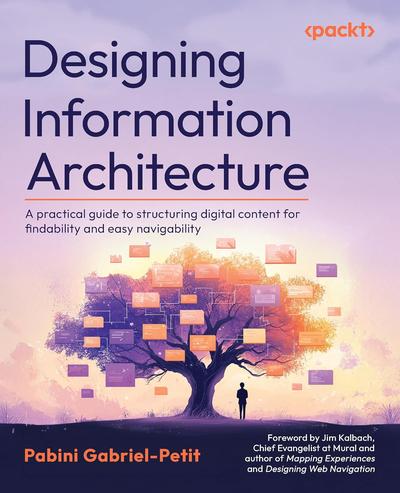English | 2025 | ISBN: 978-1838827199 | 570 Pages | PDF, EPUB | 52 MB
“A fresh, updated perspective on Information Architecture (IA), blending foundational principles with modern insights to help you design intuitive, structured, and human-centered digital experiences.”
– Jim Kalbach, Chief Evangelist at Mural
Get your hands on a well-structured, easy-reference handbook filled with IA best practices for organizing digital information spaces
Key Features
- Learn IA from Pabini Gabriel-Petit, UX expert and founder of UXmatters
- Get a practical introduction to IA in the broader context of UX research and design
- Gain expert insights from industry leaders on IA’s evolution, techniques, and applications
In a world that suffers from information overload, how can information architects help people quickly find the exact digital content they need? This is where Designing Information Architecture comes in as your practical guide to creating easy-to-use experiences for digital information spaces—be it websites, applications, or intranets—by creating well-structured information architectures (IAs) and effective navigation and search systems. It shows you how to improve the organization, findability, and usability of digital content using proven IA design methods and strategies.
Designing Information Architecture is an up-to-date resource on IA. Written by Pabini Gabriel-Petit, a recognized expert in user experience (UX) and IA with decades of industry experience, this book offers both expert insights and practical design guidance. It also explores modern, AI-driven approaches to implementing search systems that can help users overcome the challenges of information overload.
Throughout the book, you’ll learn why a well-structured information architecture remains more critical than ever in delivering effective digital information spaces.
What you will learn
- Information-seeking models, strategies, tactics, and behaviors
- Principles for designing IAs that support human cognitive and visual capabilities
- Wayfinding principles for placemaking, orientation, navigation, labeling, and search
- Useful structural patterns and information-organization schemes
- UX research methods and analytics for information architecture
- Content analysis, modeling, and mapping methods
- Categorizing content and creating controlled vocabularies
- Designing and mapping information architectures
- Leveraging artificial intelligence (AI) to deliver optimal search results
Resolve the captcha to access the links!
